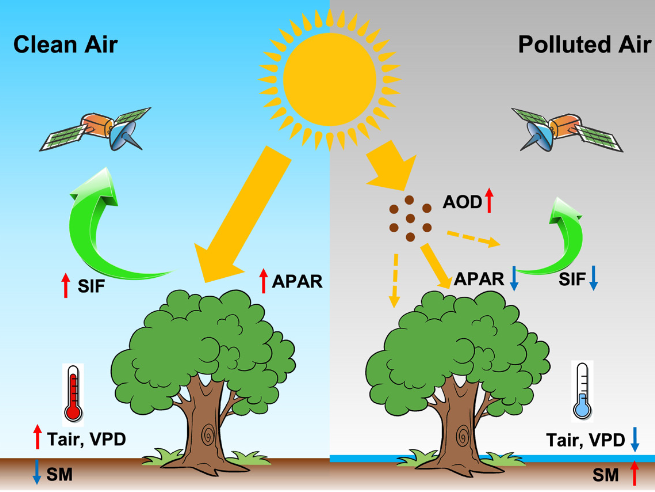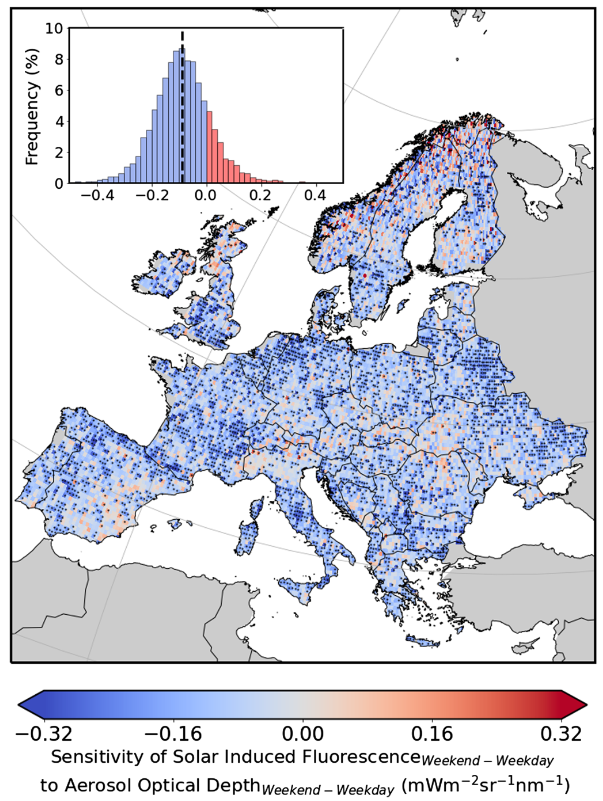We all breathe a little easier (literally!) on the weekend, when commuter-related traffic and pollution levels are lower than during the Monday-through-Friday workweek. It turns out that crops, forests, and other vegetation are also relieved.
Several studies at the plot or site scale have shown that the productivity of ecosystems declines when fine-particle (aerosol) pollution is high, largely because less sunlight reaches the plants. It’s also been shown that anthropogenic pollution follows the weekly work cycle: higher during the work week, and lower on weekends. A new study used data from satellites to show how these two phenomena are interrelated on a much bigger, continental scale over all of Europe.

Schematic showing how the solar-induced fluorescence (SIF) of plant chlorophyll is affected by the cleaner air on weekends (left) versus weekdays. Aerosol optical depth (AOD) is higher on weekdays, reducing the absorbed photosynthetically active radiation (APAR) of vegetation. The temperature of the air (Tair), vapor pressure deficit (VPD) and soil moisture are also influenced by aerosol pollution. [Credit: Figure 2A of He et al., Proceedings of the National Academy of Sciences, doi:10.1073/pnas.2306507120.]
The Tropospheric Monitoring Instrument (TROPOMI) onboard the Copernicus Sentinel-5 Precursor satellite measures solar-induced fluorescence (SIF). SIF is emitted by chlorophyll in vegetation, and is an indicator of the photosynthetic activity (“productivity”) of vegetation. The Visible Infrared Imaging Radiometer Suite (VIIRS) instrument on the Suomi satellite measures aerosol optical depth to gauge fine particle pollution. The study, published in the Proceedings of the National Academy of Sciences (PNAS), uses both data sets.
A pattern of higher photosynthetic activity over the weekend was observed in about two-thirds of Europe, while aerosol pollution was reduced over most of Europe on weekends. Using other data and modeling techniques, the authors demonstrated that the pollution was affecting the amount of sunlight reaching the vegetation, which in turn affects the photosynthetic productivity and the SIF signal seen by the satellite instrument. By focusing on weekend versus weekday differences, the study teases out the effects of human-caused aerosols (from vehicles, factories, etc.) from natural sources of aerosols (e.g., dust, pollen, sea spray), which do not have such a weekly cycle.

Figure showing how the solar-induced fluorescence (SIF) of vegetation chlorophyll is affected by a 1 unit increase in aerosol optical depth, derived from weekly patterns over Europe for 3 years (2018, 2019, 2021). The prevalence of blue shading shows the tendency for decreased ecosystem productivity when aerosols are increased. Black dots indicate statistically significant results. [Credit: Figure 3 of He et al., Proceedings of the National Academy of Sciences, doi:10.1073/pnas.2306507120.]
The PNAS study gives an interesting glimpse of how efforts to reduce pollution could not only boost ecosystem productivity, but also could benefit climate because the ecosystem would remove more of the greenhouse gas carbon dioxide (CO2) from the atmosphere.
But the authors also raise a caution flag. Some proposed geoengineering schemes would inject fine particle pollution deliberately into the atmosphere, to shield sunlight and cool Earth’s surface. The PNAS study shows that such schemes would also decrease crop yields and reduce how much CO2 is removed from the atmosphere by ecosystems. As noted by the authors, “These unforeseen results underscore the intricate nature and inherent uncertainties associated with manipulating the Earth system on a large scale, highlighting the need for cautious and comprehensive evaluations when considering geoengineering as a potential solution to global climate challenges.”
——————————–
The weekly cycle of photosynthesis in Europe reveals the negative impact of particulate pollution on ecosystem productivity, L. He, L. Rosa, D.B. Lobell, Y. Wang, Y. Yin, R. Doughty, Y. Yao, J.A. Berry, and C. Frankenberg, Proceedings of the National Academy of Sciences, doi:10.1073/pnas.2306507120, 2023.
